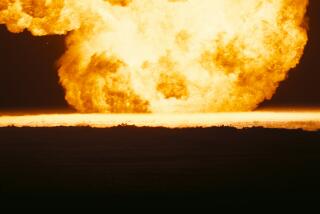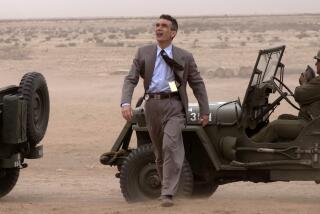Art as fission statement
- Share via
Libya wanted to build one. Some fear Iran and North Korea still do.
But a man in Hawthorne has actually done it.
Built his own atom bomb, that is. Sort of.
Robert Wilhite has reproduced “Fat Man,” the nuclear bomb that the United States dropped on Nagasaki, Japan, 63 years ago. The devastation from that blast -- coupled with that from another bomb dropped over Hiroshima -- prompted Japan to surrender, ending World War II.
Instead of a steel-clad, 5-ton teardrop packed with plutonium, Wilhite’s bomb is 135 pounds of molded poplar, mahogany and airplane-grade spruce plywood. It’s more a thing of beauty than an instrument of horror.
At least that’s the way he sees it, says Wilhite -- an artist whose work in the past has ranged from the design of furniture and flatware to paintings made from dye and metallic powder on handmade paper.
“I wanted something the opposite of heavy,” Wilhite said. “I wanted it really light and transparent. I wanted something people would react to. I want people to think about their own values: ‘It’s beautiful, but wait a minute -- this is a weapon of mass destruction.’ ”
The bomb art caused a stir on Cordary Avenue where Wilhite spent six months building it in a studio that previously served as a machine shop for the once-thriving aerospace industry.
Neighbors popped in regularly to check on its progress. A globe-trotting European adventurer made a special visit and then wrote of “a weapon of mass destruction in Los Angeles” on his travel blog.
For the past few weeks the finished bomb has stirred debate at a Dallas gallery, where it was on display.
Some viewers have been horrified. Others have remarked that the real Fat Man perhaps saved their fathers and thousands of other GIs who were poised to invade Japan as the war dragged on.
“We’ve heard everything from, ‘Why would you want to do this?’ to ‘This is a beautiful thing, but it’s scary as hell,’ ” said gallery owner Barry Whistler, who will show the bomb through July 26.
Texas art reviewers have come away with similar feelings. “Is it likely that one could feast their eyes upon a weapon of mass destruction and find a feeling of warmth?” asked one.
The bomb “presents a complicated visual and emotional mix of elegance and menace,” wrote another. “The aesthetic force of Wilhite’s sculpture oscillates between the poles of one’s attraction to its improbable beauty and the anxiety engendered by its subject matter.”
Wilhite, a 62-year-old Venice resident, said the idea for the bomb took root in the early 1970s when he was a professional water show diver working in Japan. There, he visited Hiroshima Peace Park.
He made a special trip to the National Atomic Museum in Albuquerque to measure a leftover steel bomb casing similar to that used for Fat Man before drawing full-size construction plans that take up one studio wall. Next to them are photos of the real Fat Man and an atomic bomb blast.
His own bomb suffered an explosion of sorts as Wilhite and his 23-year-old son, Axel, toted it last month to Dallas in a battered rented truck. The rough ride, coupled with Arizona desert heat, caused the artwork’s black-lacquer lattice sides to began popping loose. The pair had to stop and re-glue parts of the bomb together.
At a New Mexico truck weigh station, authorities questioned Wilhite about the commercial value of his load. He said he elected not to trigger a Homeland Security alert by joking that his cargo was a weapon of mass destruction.
If his bomb isn’t bought by a collector in Dallas, Wilhite plans to return it to the Los Angeles area at month’s end. Then he intends to build a companion piece for it: Hiroshima’s “Little Boy” bomb.
Asking price for his atomic bomb is $50,000.
Any interest, Kim Jong-Il?
--
More to Read
The biggest entertainment stories
Get our big stories about Hollywood, film, television, music, arts, culture and more right in your inbox as soon as they publish.
You may occasionally receive promotional content from the Los Angeles Times.











